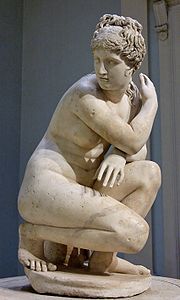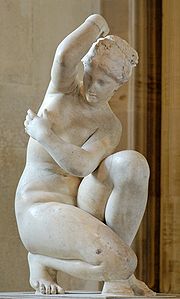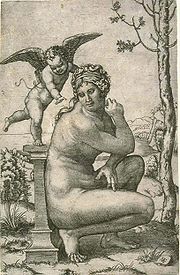
Crouching Venus
Encyclopedia

- This article discusses the type itself: see links within it for specific instances of the type.
The Crouching Venus is a Hellenistic model of Venus
Venus (mythology)
Venus is a Roman goddess principally associated with love, beauty, sex,sexual seduction and fertility, who played a key role in many Roman religious festivals and myths...
surprised at her bath. Venus crouches with her right knee close to the ground, turns her head to the right and, in most versions, reaches her right arm over to her left shoulder to cover her breasts. To judge by the number of copies that have been excavated on Roman
Ancient Rome
Ancient Rome was a thriving civilization that grew on the Italian Peninsula as early as the 8th century BC. Located along the Mediterranean Sea and centered on the city of Rome, it expanded to one of the largest empires in the ancient world....
sites in Italy and France
Roman Gaul
Roman Gaul consisted of an area of provincial rule in the Roman Empire, in modern day France, Belgium, Luxembourg, and western Germany. Roman control of the area lasted for less than 500 years....
, this variant on Venus seems to have been popular.
A number of examples of the Crouching Venus in prominent collections have influenced modern sculptors since Giambologna
Giambologna
Giambologna, born as Jean Boulogne, incorrectly known as Giovanni da Bologna and Giovanni Bologna , was a sculptor, known for his marble and bronze statuary in a late Renaissance or Mannerist style.- Biography :...
and have been drawn by artists since Martin Heemskerck, who made a drawing of the Farnese Crouching Venus that is now in Naples
Naples
Naples is a city in Southern Italy, situated on the country's west coast by the Gulf of Naples. Lying between two notable volcanic regions, Mount Vesuvius and the Phlegraean Fields, it is the capital of the region of Campania and of the province of Naples...
.
Attribution
The model is often related to a corrupt passage in Pliny the ElderPliny the Elder
Gaius Plinius Secundus , better known as Pliny the Elder, was a Roman author, naturalist, and natural philosopher, as well as naval and army commander of the early Roman Empire, and personal friend of the emperor Vespasian...
's Natural History (xxxvi.35), enumerating sculptures in the Temple of Jupiter Stator
Temple of Jupiter Stator (2nd century BC)
The Temple of Jupiter Stator was a temple of Ancient Rome named after the god Jupiter in his form of Jupiter Stator . Together with the temple of Juno Regina and the enclosing Porticus Metelli , it was built by Q. Caecilius Metellus Macedonicus after his triumph in 146 BC...
in the Portico of Octavia
Porticus Octaviae
The Porticus Octaviae is an ancient structure in Rome.Built by Augustus in the name of his sister, Octavia Minor, at some time after 27 BC, in place of the Porticus Metelli, the porticus enclosed within its colonnaded walks the temples of Jupiter Stator and Juno Regina, next to the Theater of...
, near the Roman Forum
Roman Forum
The Roman Forum is a rectangular forum surrounded by the ruins of several important ancient government buildings at the center of the city of Rome. Citizens of the ancient city referred to this space, originally a marketplace, as the Forum Magnum, or simply the Forum...
; the text has been emended to a mention of Venerem lavantem sese Daedalsas, stantem Polycharmus ("Venus washing herself, of Daedalsas, [and another], standing, of Polycharmus"), recording a sculpture of a Venus who was not standing, by the otherwise unknown Doidalses or Daedalsas.
Ancient examples
Such terse archival references and so many existing ancient versions make archival identification of the Roman copies insecure, though some include a water jar and/or an additional figure of ErosEros
Eros , in Greek mythology, was the Greek god of love. His Roman counterpart was Cupid . Some myths make him a primordial god, while in other myths, he is the son of Aphrodite....
which make identification easier (e.g. the Hermitage example, and http://www.hermitagemuseum.org/fcgi-bin/db2www/descrPage.mac/descrPage?selLang=English&indexClass=SCULPTURE_EN&Query_Exp=%28WOA_TYPE+%3D%3D+%22Freestanding+Sculpture%22%29+AND+%28WOA_CNTR_ORG+%3D%3D+%22Ancient+Rome%22%29&PID=A-370&numView=1&ID_NUM=4&thumbFile=%2Ftmplobs%2FO2TED0R5BLO5U2YX6.jpg&embViewVer=last&comeFrom=browse&check=false&sorting=WOA_AUTHOR%5EWOA_NAME&thumbId=6&numResults=113&author=here]). The Crouching Venus was often paired with the other famous crouching sculpture of Antiquity, the Arrotino
Arrotino
The Arrotino , or formerly the Scythian, thought to be a figure from a group representing the Flaying of Marsyas is a Hellenistic-Roman sculpture of a man crouching to sharpen a knife on a whetstone.The sculpture was excavated in the early sixteenth century, for it is recognizable in an inventory...
.
- The Crouching Venus of the MediciMediciThe House of Medici or Famiglia de' Medici was a political dynasty, banking family and later royal house that first began to gather prominence under Cosimo de' Medici in the Republic of Florence during the late 14th century. The family originated in the Mugello region of the Tuscan countryside,...
collection, noted at Villa MediciVilla MediciThe Villa Medici is a mannerist villa and an architectural complex with a garden contiguous with the larger Borghese gardens, on the Pincian Hill next to Trinità dei Monti in Rome, Italy. The Villa Medici, founded by Ferdinando I de' Medici, Grand Duke of Tuscany and now property of the French...
, Rome, is now at the UffiziUffiziThe Uffizi Gallery , is a museum in Florence, Italy. It is one of the oldest and most famous art museums of the Western world.-History:...
in FlorenceFlorenceFlorence is the capital city of the Italian region of Tuscany and of the province of Florence. It is the most populous city in Tuscany, with approximately 370,000 inhabitants, expanding to over 1.5 million in the metropolitan area....
. It was engraved (with its restored sea-shell - see here) by Paolo Alessandro Maffei, Raccolta di statue antiche e moderni..., 1704 (plate XXVIII)
- The Crouching Venus of the Farnese collection of marbles, restored with a small Eros who engages the goddess's attention, is now in the Museo Archeologico Nazionale, Naples. It was drawn by Martin Heemskerck.http://www.theoi.com/Gallery/S10.14.html
- The Crouching Venus of the Borghese collection, purchased in 1807 from Camillo Borghese, now in the Louvre. In the Borghese collection it had been freely restored as a Diana, holding her hunting bow in her right hand.

- The Lely VenusLely VenusThe Lely Venus is an instance of the Crouching Venus type of Hellenistic marble statue. It is of Antonine date.It was originally in the Gonzaga collection in Mantua, where it was inventoried in the Gonzaga collection in 1627 Whilst there it was seen by the artist Rubens, who stayed with the...
(main image, above) is an Antonine marble that was in the GonzagaHouse of GonzagaThe Gonzaga family ruled Mantua in Northern Italy from 1328 to 1708.-History:In 1433, Gianfrancesco I assumed the title of Marquis of Mantua, and in 1530 Federico II received the title of Duke of Mantua. In 1531, the family acquired the Duchy of Monferrato through marriage...
collection, Mantua, where it was inventoried in the Gonzaga collection in 1627 and was remarked in England in 1631 as "the finest statue of all" and valued at 6000 ecusÉcu (coin)The term écu may refer to one of several French coins. The first écu was a gold coin minted during the reign of Louis IX of France, in 1266. Ecu means shield, and the coin was so called because its design included a shield bearing a coat of arms. The word is related to scudo and escudo...
. It was purchased in 1627-28 from the Gonzagas for Charles I of EnglandCharles I of EnglandCharles I was King of England, King of Scotland, and King of Ireland from 27 March 1625 until his execution in 1649. Charles engaged in a struggle for power with the Parliament of England, attempting to obtain royal revenue whilst Parliament sought to curb his Royal prerogative which Charles...
, whose art collections were dispersed during the CommonwealthCommonwealth of EnglandThe Commonwealth of England was the republic which ruled first England, and then Ireland and Scotland from 1649 to 1660. Between 1653–1659 it was known as the Commonwealth of England, Scotland and Ireland...
, when it was purchased by the painter and connoisseur Sir Peter LelyPeter LelySir Peter Lely was a painter of Dutch origin, whose career was nearly all spent in England, where he became the dominant portrait painter to the court.-Life:...
. It passed once again into the Royal Collection in 1682 and is on loan to the British MuseumBritish MuseumThe British Museum is a museum of human history and culture in London. Its collections, which number more than seven million objects, are amongst the largest and most comprehensive in the world and originate from all continents, illustrating and documenting the story of human culture from its...
http://www.thebritishmuseum.ac.uk/explore/highlights/highlight_objects/gr/m/marble_statue_of_a_naked_aphro.aspx.
- The Crouching Venus excavated at Salona (modern Solin near Split, CroatiaSplit (city)Split is a Mediterranean city on the eastern shores of the Adriatic Sea, centered around the ancient Roman Palace of the Emperor Diocletian and its wide port bay. With a population of 178,192 citizens, and a metropolitan area numbering up to 467,899, Split is by far the largest Dalmatian city and...
) in the second half of the 18th century was purchased for the Vatican Museums, where it was etched by Francesco, the son of Giovanni Battista PiranesiGiovanni Battista PiranesiGiovanni Battista Piranesi was an Italian artist famous for his etchings of Rome and of fictitious and atmospheric "prisons" .-His Life:...
, then confiscated by the French under NapoleonNapoleon I of FranceNapoleon Bonaparte was a French military and political leader during the latter stages of the French Revolution.As Napoleon I, he was Emperor of the French from 1804 to 1815...
but returned to the Vatican in 1816, where it remains.
- The Vénus Accroupie, is a 2nd-century crouching Venus from the collection of Louis XIVLouis XIV of FranceLouis XIV , known as Louis the Great or the Sun King , was a Bourbon monarch who ruled as King of France and Navarre. His reign, from 1643 to his death in 1715, began at the age of four and lasted seventy-two years, three months, and eighteen days...
, now in the Musée du Louvre. In a variation, her right arm is raised behind her head.http://www.theoi.com/Gallery/S10.11.html
- The Crouching Venus of Vienne, 1st or 2nd-century CE, considered one of the finest Roman marbles of this type, was excavated in 1828 at Sainte-Colombe, on the right bank of the Rhône, part of the ancient city of VienneVienneVienne is the northernmost département of the Poitou-Charentes region of France, named after the river Vienne.- Viennese history :Vienne is one of the original 83 departments, established on March 4, 1790 during the French Revolution. It was created from parts of the former provinces of Poitou,...
which lies across the river; it was purchased from the Gerantet collection in 1878 for the Louvre, where CézannePaul CézannePaul Cézanne was a French artist and Post-Impressionist painter whose work laid the foundations of the transition from the 19th century conception of artistic endeavour to a new and radically different world of art in the 20th century. Cézanne can be said to form the bridge between late 19th...
drew it and adapted it for one of the figures in his Grande Baigneuses (Philadelphia). The remains of a small hand on her back show that this was one of the versions that included a little Eros
- A Crouching Venus that was excavated at that quarry of antiquities, Hadrian's VillaHadrian's VillaThe Hadrian's Villa is a large Roman archaeological complex at Tivoli, Italy.- History :The villa was constructed at Tibur as a retreat from Rome for Roman Emperor Hadrian during the second and third decades of the 2nd century AD...
at TivoliTivoli, ItalyTivoli , the classical Tibur, is an ancient Italian town in Lazio, about 30 km east-north-east of Rome, at the falls of the Aniene river where it issues from the Sabine hills...
, in the 1920s, is accounted among the finest of the Roman versions (Haskell and Penny 1981:323). It is conserved in essentially unrestored condition in the Museo Nazionale delle Terme, Rome.
- A small marble Crouching Aphrodite of the 1st century BCE, discovered in RhodesRhodesRhodes is an island in Greece, located in the eastern Aegean Sea. It is the largest of the Dodecanese islands in terms of both land area and population, with a population of 117,007, and also the island group's historical capital. Administratively the island forms a separate municipality within...
and conserved in the Rhodes Archaeological Museum, is a variant of the pose in which - instead of attempting to cover up modestly - Venus lifts her hair in her fingers to dry it, looks out at the viewer and openly displays her breasts. The type is sometimes distinguished as the Crouching Aphrodite of Rhodes.
Small ancient bronzes of the Crouching Venus have survived. One, found in Syria, and formerly in the collection of Joseph Durighello, was sold by the Galerie Georges Petit, Paris.
Appreciation in the Renaissance

Venus Anadyomene
Venus Anadyomene was one of the iconic representations of Aphrodite, made famous in a much-admired painting by Apelles, now lost, but described in Pliny's Natural History, with the anecdote that the great Apelles employed Campaspe, a mistress of Alexander the Great, for his model...
— encouraged the restoration of a shell upon which she crouches, in which form the Medici sculpture was engraved by Paolo Alessandro Maffei, Raccolta di statue antiche e moderni..., 1704 (plate XXVIII)
Versions since the Renaissance
Several versions of the Crouching Venus issued from the atelier of GiambolognaGiambologna
Giambologna, born as Jean Boulogne, incorrectly known as Giovanni da Bologna and Giovanni Bologna , was a sculptor, known for his marble and bronze statuary in a late Renaissance or Mannerist style.- Biography :...
and his heir Antonio Susini; among examples of Susini's bronze reduction, one from the collection of Louis XIV is conserved in the Holburne Museum of Art, Bath, while another, in the collection of Prince Carl Eusebius von Liechtenstein
Karl Eusebius of Liechtenstein
Karl Eusebius, Prince of Liechtenstein was the Prince of Liechtenstein. He inherited this title in 1627 from his father Karl I. He was 16 and thus considered underage and his uncles Prince Gundakar and Maximillian acted as regents until 1632...
by 1658, remains in the Liechtenstein collection, Vienna
Vienna
Vienna is the capital and largest city of the Republic of Austria and one of the nine states of Austria. Vienna is Austria's primary city, with a population of about 1.723 million , and is by far the largest city in Austria, as well as its cultural, economic, and political centre...
.
- A famous variant in marble was delivered by Antoine CoysevoxAntoine CoysevoxCharles Antoine Coysevox , French sculptor, was born at Lyon, and belonged to a family which had emigrated from Spain...
in 1686 for the Château de MarlyChâteau de MarlyThe Château de Marly was a relatively small French royal residence located in what has become Marly-le-Roi, the commune that existed at the edge of the royal park. The town that originally grew up to service the château is now a dormitory community for Paris....
; Coysevox, who set his Venus on a tortoiseTortoiseTortoises are a family of land-dwelling reptiles of the order of turtles . Like their marine cousins, the sea turtles, tortoises are shielded from predators by a shell. The top part of the shell is the carapace, the underside is the plastron, and the two are connected by the bridge. The tortoise...
rather than a shell, was so exultant in his success that he inscribed the name of PhidiasPhidiasPhidias or the great Pheidias , was a Greek sculptor, painter and architect, who lived in the 5th century BC, and is commonly regarded as one of the greatest of all sculptors of Classical Greece: Phidias' Statue of Zeus at Olympia was one of the Seven Wonders of the Ancient World...
in GreekGreek languageGreek is an independent branch of the Indo-European family of languages. Native to the southern Balkans, it has the longest documented history of any Indo-European language, spanning 34 centuries of written records. Its writing system has been the Greek alphabet for the majority of its history;...
as well as his own. The sculpture pleased the kingLouis XIV of FranceLouis XIV , known as Louis the Great or the Sun King , was a Bourbon monarch who ruled as King of France and Navarre. His reign, from 1643 to his death in 1715, began at the age of four and lasted seventy-two years, three months, and eighteen days...
to the extent that a bronze version was cast. Today the Marly marble is at the Musée du Louvre and the Marly bronze is at the Château de VersaillesPalace of VersaillesThe Palace of Versailles , or simply Versailles, is a royal château in Versailles in the Île-de-France region of France. In French it is the Château de Versailles....
.
- At Caserta PalaceCaserta PalaceThe Royal Palace of Caserta is a former royal residence in Caserta, southern Italy, constructed for the Bourbon kings of Naples. It was the largest palace and one of the largest buildings erected in Europe during the 18th century...
, the would-be Versailles outside Naples, a marble copy by Tomasso Solari was provided for the vast gardens in 1762 (Haskell and Penny 1981:323).
- Jean-Baptiste CarpeauxJean-Baptiste CarpeauxJean-Baptiste Carpeaux was a French sculptor and painter.Born in Valenciennes, Nord, son of a mason, his early studies were under François Rude. Carpeaux entered the Ecole des Beaux-Arts in 1844 and won the Prix de Rome in 1854, and moving to Rome to find inspiration, he there studied the works of...
's Crouching Flora (ca 1873), in the Museu Calouste GulbenkianMuseu Calouste GulbenkianMuseu Calouste Gulbenkian is a museum in Lisbon, Portugal, containing a collection of ancient, and some modern art...
, Lisbon, reinterprets the familiar pose.

Further reading
- Beard, Mary and John Henderson, 2001. Classical Art: from Greece to Rome (Oxford University Press)
- Lullies, Reinhard, 1954. Die kauernde Aphrodite (Munich: Filser)
External links
- Kauernde Aphrodite Documentary photos

